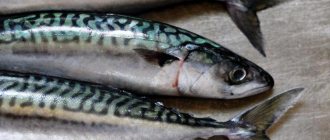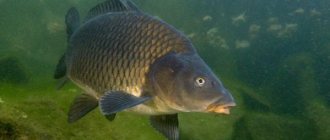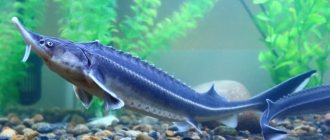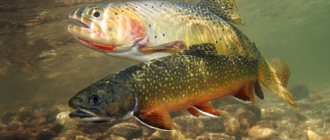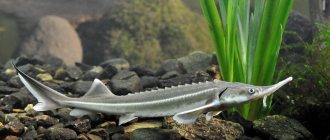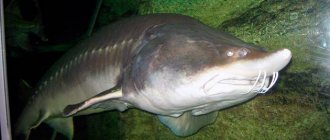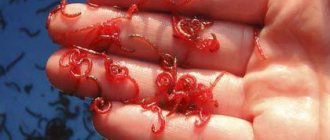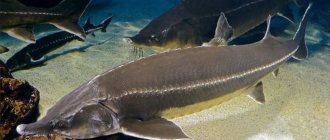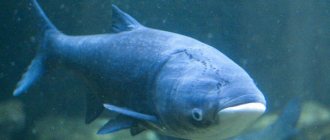Pike is the most famous and popular predator fish living in freshwater bodies of Eurasia and North America. Pike leads a solitary lifestyle, living in the coastal zone, in thickets of aquatic plants in rivers and lakes. Pike belongs to the pike family, the genus pike. The genus Pike includes five species of fish, three of which (Redfin pike, Black pike, Muskiong pike) are found only in North America and two species, Common pike and Amur pike, are found in our country. Pike is a very popular fish among anglers, especially among spinning anglers.
Appearance
Pike body
The pike has a torpedo-shaped elongated body, with fins shifted towards the tail. The whole appearance of the pike speaks of its ability to develop high speed with lightning speed.
Pike fins have a rounded shape, their whole appearance speaks of the excellent hydrodynamic properties of the pike. A long body with large dorsal and anal fins and a muscular tail give the pike the ability to move quickly. True, it can only pursue its prey in short bursts.
The pike has a large, elongated head, a wide mouth, and the lower jaw protrudes slightly forward.
The pike's snout is wide and elongated, somewhat reminiscent of the muzzle of a crocodile. The pike's mouth has a large gripping area; the gill membranes are separated from each other, allowing the pike to open its mouth very wide. Thanks to this, the pike can swallow food of large sizes, up to 2/3 of its own length. Fishermen know this feature of pike, so they often use large baits when fishing for pike.
The entire body of the pike is covered with small scales closely adjacent to each other, which form a dense monolithic cover that reliably protects the body of the pike from the teeth of other pikes.
Body coloring
Pike differ greatly from each other in color. The color can be very different and depends on the age of the pike, the aquatic environment, food supply and other environmental conditions.
The main color of pike scales is gray-green; spots of different shades from yellowish and olive to brown are scattered on a gray background. The spots form transverse stripes on the sides of the pike. The back of the pike is dark, the belly is light yellow or grayish-white.
The coloring of pike has an important camouflage function. A camouflage pattern of transverse stripes and spots scattered throughout the pike’s body makes the pike invisible in the pond. The camouflage pattern on the pike’s body is especially effective in areas with dense vegetation and snags.
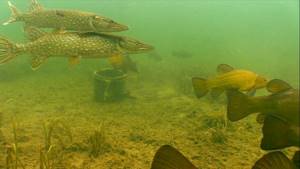
The color depends on the age of the pike: young pikes have a lighter color, adults have a darker body color.
The color of pikes greatly depends on their habitat. Pike living in peat and silted reservoirs have a dark body color. Pike living in reservoirs with clear water and a sandy bottom are light in color. Pike living among underwater vegetation, the so-called grass fish, have a greenish body color.
The paired fins of pike are orange or red, the unpaired fins are yellowish-brown, brown or gray with light streaks and stripes.
Females and males of pike do not differ in body color. The female differs from the male in the larger size and shape of the urogenital opening. The urogenital opening of a female pike is an oval depression surrounded by a pink ridge, and in males it looks like a narrow oblong slit.
Mouth, vision, sense organs
The pike has good eyesight, its wedge-shaped snout is designed in such a way that the high-set eyes of the pike allow it to see very well what is in front of it, above it, on the sides of it and even just below it if the object is slightly ahead.
The wide mouth prevents the pike from seeing objects that are below it at a close distance.
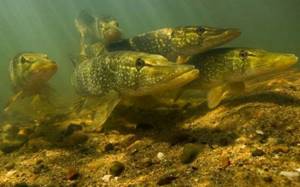
Pike have binocular vision and can well determine the distance to moving objects and the speed of their movement. Scientists' experiments show that pike can distinguish more than 20 color shades.
Pike has a well-developed olfactory apparatus, thanks to which at certain periods it can feed on carrion from the bottom of the reservoir.
The pike has a well-developed lateral line organ. Thanks to this organ, pike can hunt even in muddy water and detect the source of the slightest fluctuations in water from a great distance.
Experiments show that even a completely blind pike can successfully obtain food for many years, precisely thanks to the lateral line organ.
Predator teeth and their replacement
The pike's huge mouth is lined with sharp teeth. All pike teeth are not used for chewing food, but for capturing and killing prey. Some of the teeth are located on the jaws; they look like sharp fangs of different sizes, located at some distance from each other.
In addition to the fangs, on the jaws, palate, tongue and cheeks of the pike there are bristle teeth that resemble the bristles of a toothbrush in appearance. The bristle teeth are directed with their sharp ends towards the pharynx and in the normal state are immersed in the mucous membrane. These teeth help the pike hold on and make it easier to swallow prey. When the prey tries to escape from the mouth, the bristle teeth rest against it with their tips and do not allow it to slip out, pushing the prey further into the throat.
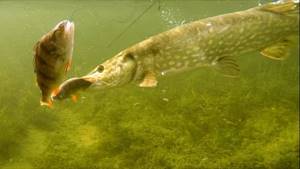
There is a legend among fishermen that after spawning and during the full moon, the pike’s teeth change and because of this it stops feeding and is not caught at this time.
In fact, the change of teeth in pike is a continuous process that occurs constantly throughout the life of the pike. The change of teeth in pike has no connection with spawning and the full moon. The passivity of pike and the lack of biting is not associated with a change of teeth, but is explained by a loss of strength due to spawning.
Each tooth in the lower jaw of a pike is adjacent to 2-4 replacement teeth, which are hidden under the soft tissue of the inner surface of the jaw. The active tooth and its replacement teeth together form a dental family. When a pike's working tooth goes out of use, its place is taken by a replacement tooth; at first it is soft and not very stable, but then its base grows to the pike's jaw and becomes strong.
You may be interested in: Wobblers
The change of teeth does not occur simultaneously in pike. If you examine the teeth of a caught pike, you will see old, dissolving teeth, strong working teeth, and new, still mobile, young teeth.
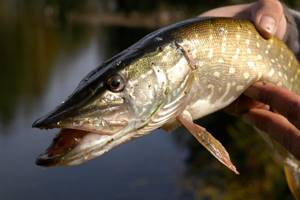
The sharp teeth of a pike can cause a lot of trouble for inexperienced fishermen who have not yet learned how to properly handle the caught fish. Even a scratch from the small teeth of a small pike is very painful and does not heal for a long time. In addition to the teeth, the sharp edges of the pike's gill covers, which can easily cut oneself, pose a danger to the fisherman.
You need to remove the caught pike from the water with a special landing net. Before handling a pike, it is advisable to wear gloves with a protective coating. To remove the bait from the pike's mouth, its mouth is securely fixed with a gaper, and the bait itself is removed with an extractor, while the pike's head is carefully held with one hand under the gills, pressing it against a hard surface.
Replacement
After falling out, the resulting void is quickly closed by a fang that grew nearby. Meanwhile, a new element begins to develop along the edge of the dentition. Young pike fangs differ from old ones even visually: they are white in color and have a shiny, smooth surface. At first, young fangs are small in size and do not have a massive thickening under the lower part. Therefore, the connection with the jaw bones is movable, unfixed; they remain in place only due to being held inside the mucous layer. If you put pressure on such a fang, it bends to the side, and if you press hard, it can completely fall out or break.

Over time, the size increases, and the attachment becomes more rigid, and the pike tooth stops deflecting when pressed. A connection is formed between the lower end and the bone, very reminiscent of cartilage. Then it hardens like bone tissue and firmly connects the tooth to the pike’s jaw.
The laying of the rudiments of future teeth occurs long before they “erupt.” On each jaw you can find several dozen fangs hidden in the thickness of soft tissue, waiting in the wings.
Regarding the teeth that are located on the upper jaw, on the cheeks, tongue and at the entrance to the pharynx, it has not yet been established whether they are being replaced or not. At the moment, the study of this topic continues, so pike remains a close object of research for ichthyologists.
Age and size of pike
The size and weight of large pikes are legendary. Leonid Sabaneev mentions the legendary pike caught in 1497 in Germany; the ring of the Holy Roman Emperor Frederick II, marked 1230, was found on the pike. Thus, according to this legend, the fish was 267 years old, weighed 140 kg and had a length of 5.7 meters. The spine of this legendary pike was transferred for safekeeping to the cathedral of the German city of Mannheim. Scientists examined this spine and found that it was just a hoax; the spine was assembled from the vertebrae of several individual pikes.
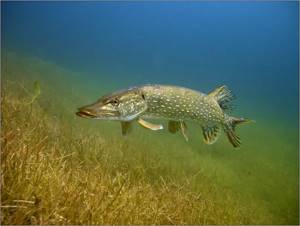
The history of Tsar Boris Fedorovich’s pike is known. Legend has it that in 1794, while cleaning the Tsaritsinsky ponds, a pike with a ring on the gill cover was caught. The inscription “Planted by Tsar Boris Fedorovich” was engraved on the ring. Thus, it turned out that the caught pike was more than 200 years old. This whole story is nothing more than a legend; no documentary evidence of this story has been preserved.
According to legends that have come down to us, pike weighing 56 kg were caught in the Ural lakes, a pike weighing 64 kg was caught in Lake Onega, and a specimen weighing 80 kg was caught in the Vychegda River.
The maximum size of pike reaches, apparently, 1.6 - 1.9 meters, maximum weight 26-35 kg, this is indicated by documented data on the industrial catch of pike.
In order to grow to a weight of 20 kg, a pike must live more than 30 years. It is possible that such huge pikes are still preserved somewhere.
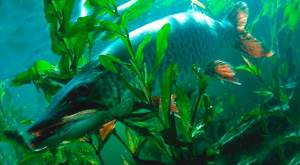
The largest pikes live in wild northern rivers, rarely visited by people; in such places, predators can live to a very old age.
Most often, anglers catch pike with a maximum length of 50 - 70 cm, weighing 1.2 - 3 kg. Pike weighing from 3 to 7 kg are considered large these days. Specimens weighing more than 8 kg are already considered trophy; many fishermen have never managed to catch a fish of this size in their entire lives.
There are legends that pike can live up to 100 years, but these are just legends, the average life expectancy of pike is 18-20 years, under ideal conditions pike can live up to 30 years. But pike, as a rule, do not live to this age, due to catch by fishermen, death in winter from lack of oxygen in the water and freezing of reservoirs to the bottom in especially cold winters.
Lifestyle and behavior

A few words about pike. On the hook, the pike desperately resists, shakes its head like a dog, and makes “candles.”
But how many pleasant experiences, how much adrenaline such a fight brings! And if the pike is caught, and even if a strong fish breaks loose and deservedly gains the desired freedom, the fisherman will still never forget the minutes of the wonderful fight. That's why fishermen love to catch pike. That's why they appreciate her. And when it comes to pike, no one remains indifferent.
It is known about pike that it can eat a wide variety of foods: fish, including its own young, frogs, small rodents. A relatively large pike is capable of dragging a duckling, a baby muskrat or a water rat underwater and swallowing it. It happens that by autumn, pikes eat up everything living and at least somewhat attractive in the lakes, and, hungry, they eat water snails. They collect them clumsily, but with enviable tenacity; in a day they fill their stomachs with heavy food so much that they then swim with difficulty.
READ How to choose the right reel for sea fishing
Often a pike grabs prey that is not much smaller than its own length. The pike cannot swallow it right away, nor can it bite off a piece, so it has to digest the victim gradually. While the prey's head is being digested in the pike's stomach, the tail sticks out from the toothy mouth. But the point here is not at all about pike greed, but about the structure of the pike’s teeth.
Where does pike live?
Pike is distributed throughout almost the entire territory of Russia and neighboring countries, with the exception of the regions of the Far North. Pike is undemanding to living conditions and can live in almost any body of water: large and small rivers, lakes, reservoirs, ponds and flooded quarries. Pike can survive in almost any body of water, as long as it does not freeze to the bottom in winter and is supplied with fresh, oxygen-rich water from a spring, stream or river.
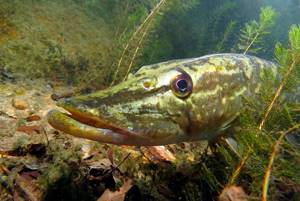
Pike tolerates brackish water well and can live in desalinated parts of the seas; in the Baltic Sea, pike is found in the Gulf of Finland, Riga and Curonian Gulfs; in the Sea of Azov, pike is found in the Taganrog Bay. There are also references to pike fishing in the Black, Aral and Caspian Seas.
Sometimes pike are found in bodies of water that have no connection with rivers and lakes. Pike eggs are brought into such reservoirs by waterfowl; there is a theory that fertilized pike eggs pass through the stomach of waterfowl without losing their properties.
Pike does not like fast currents and prefers to stay in quiet places.
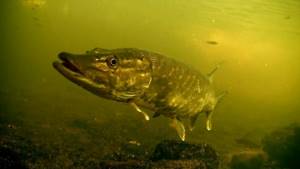
Until a certain age, pike tries to stay in the coastal zone, in the grass, in snags. Reaching large sizes and a weight of 3-4 kg, the pike moves deeper into the pits.
Fishermen even conditionally divide pike into two subspecies:
- grass pike, a small fish that lives in the coastal zone, near grass and snags;
- deep-sea pike, a fish of large size and weight hiding in the depths.
Mouth, vision, sense organs

The flattened wedge-shaped snout of the pike opens up an additional viewing area, increasing the sector of the binocular - frontal field of vision, with which the pike evaluates the speed of moving objects and the distance to them.
Thanks to this structural feature of the skull and high-set eyes, Shch can view the water area above him as well as from the side, and it’s good to see oncoming objects below him.
But the wide mouth reduces the angle of vision of the lower space, preventing it from seeing the target at close range if it is below its level.
Anglers who know this feature try not to “feed” bait close to the bottom and use spinning baits based on this.
It should be noted that the predator hears as well as sees. Thanks to the lateral line, it can hunt even in muddy water, catching the source of the slightest fluctuations in the aquatic environment from a great distance.
An experiment conducted with a blind individual that has been successfully obtaining food for many years indicates how developed and sensitive this organ is in pikes.
What does pike eat?
Pike is a predatory fish that feeds on a wide variety of animal foods. The basis of the pike diet is all kinds of fish. Already, pike fry, whose size barely reaches 1.5 cm and the basis of their diet is zooplankton, are trying to hunt the larvae of various small fish. Having reached a size of 5 cm, pike completely switch to feeding on fish.
Pike are not particularly picky about their diet; they eat whatever they can catch. Among the fish, pike prefer: crucian carp, roach, bream, silver bream, perch, goby, whitefish, bream, roach, ruffe, gudgeon, char, and minnow.
You may be interested in: How to choose a spinning reel
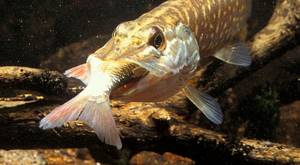
Pike treats ruffs, perches and pike perch with caution, which have sharp fins and can injure the pike with them. Pike does not really like burbot and tench because of their unpleasant mucus. Having caught a ruff or perch, the pike squeezes it with its jaws for a long time until it feels that its victim has completely stopped resisting and only then swallows it.
Pike often eat other pike if they are smaller in size. Anglers often catch large pike weighing up to 4 kg, with lacerations on their sides. Such wounds indicate that there are even larger pikes in the reservoir, and the caught pike became a victim of their attack. A pike weighing 15 kg, which is 20-25 years old, can eat another pike weighing 8 kg.
In spring and the first half of summer, pike happily eat frogs and molting crayfish. In autumn, during migration, various rodents (mice, rats and squirrels) swim across rivers and often become prey for large pikes. A large pike can grab and drag a duckling, and sometimes even an adult duck, under water, especially during molting, when the duck has difficulty rising into the air. Cases are mentioned when pikes even grabbed geese.
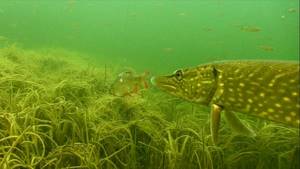
The gluttony of the pike is evidenced by the fact that it is able to swallow food reaching a size of 50-65% of its own weight and size.
Having caught the prey, the pike turns it head first and then swallows it; if the pike cannot swallow its prey completely, it waits until the swallowed part of the prey is digested and then swallows the rest of the prey.
Food in the stomach of pikes is digested very slowly, which is why pikes are so voracious, they have to fill their digestive tract completely to capacity. The pike regurgitates scales and other solid undigested food debris.
Pike feed irregularly; after eating, the pike can digest food for several days and not hunt during this entire time.

The time when pike are actively feeding is commonly called zhor by fishermen. There are three periods of pike feeding: pre-spawning feeding occurs in early spring, post-spawning feeding occurs in April-May, and autumn feeding occurs in the fall with cooling temperatures.
The time of active feeding can be determined by the behavior of the pike. During zhora, the pike often jumps out of the water and starts a fry fight, during which the fry jumps out of the water in different directions. It happens that, carried away by the pursuit of a fry, a pike even jumps out onto the shore during a feast.
How many teeth does a pike have?
Beginning fishermen often ask the question: “What is the pike’s body covered with?”
Such questions arise due to the fact that the entire body is covered with a very dense layer of small scales, which in turn are covered with mucus. The toothy body shape is cylindrical, elongated with a large flattened head, partially covered with scales in the area of the cheeks and gill formations. The lower jaw is strongly set forward with powerful, sharp teeth.

How does pike hunt?
Due to the cannibalism inherent in pikes, pikes cannot live in a school and lead an exclusively solitary lifestyle. Only during spawning can pikes stay in small groups of 4-5 individuals.
Pike is an ambush predator. The pike stays in thickets of aquatic vegetation, near snags, while it hides and stands absolutely motionless, making swift, lightning-fast throws at small fish swimming past. For ambush, the pike chooses shallow grassy places, thickets of reeds, and snags.
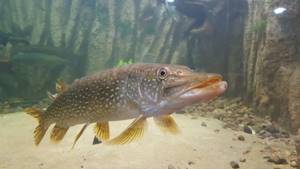
Small and medium-sized pike choose thickets of reeds, cattails and other aquatic vegetation for ambush. Large pike try to stay in the depths, choosing an ambush site in the form of a snag or a flooded bush.
During its hunt, the pike uses not only vision, but also the lateral line organ, which is located not only along the pike’s body, but also on the head. Especially many lateral line sensors are located on the anterior part of the lower jaw.

During the zhora period, the pike changes its hunting tactics; instead of passively standing in ambush, it begins to actively patrol its hunting grounds and, having discovered potential prey, aggressively pursues and attacks it.
In the winter season, pike activity decreases, it hunts less and feeds much less often.

On clear, warm, sunny days, pike swim up to the very shore, stick their dark backs up and stand motionless for a long time, basking in the sun. Large pikes do not come so close to the shore, but they also float to the surface, somewhere in the grass thickets. If a fisherman, moving along the shore, scares off pikes basking in the sun, they dive with a loud splash and move away from the shore, but do not move far from their favorite place.
How does hair loss occur?
After the fang has performed its function for a long time, it begins to gradually fade or become yellow. The channels through which nutrients were supplied to it slowly atrophy, and it remains isolated. Within a few weeks it dies, its attachment to the jaw dissolves, it becomes mobile, and then falls out.
The same thing happens with damaged, but not yet old, pike fangs that have lost their sharp upper edge. Without a point, they cannot properly perform the gripping function, so they become unnecessary and fall out. This process is painless, bloodless and unnoticed by the fish.
Reproduction
Female pike begin to participate in reproduction from the age of 3-4 years, the body length of pike at this age is 35-40 cm, males participate in reproduction from the age of 5 years.
Pike is the very first freshwater fish to spawn; spawning begins in March immediately after the ice melts. The peak of spawning occurs during high water, when the water temperature is 3–6 degrees. In lakes and reservoirs, spawning occurs somewhat later, since the ice cover remains on them longer.
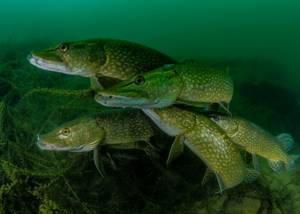
During spawning, pike goes aground and enters the mouths of small rivers and streams, lakes and water meadows. The depth of the water where spawning occurs is usually 0.5-1 meter. For spawning, pike choose places with a quiet current. Smaller pikes begin spawning, and the largest ones finish. Pike spawning can last up to 4 weeks. During spawning, pikes stay in groups, usually 2-4 males stay around one female; large females can keep up to 8 males.
During spawning, the female pike swims in front, and the males swim behind her, slightly behind her. Males either cling to the sides or stay above the back of the female. During spawning, the dorsal fins and backs of fish are constantly visible above the water. Constantly moving around the spawning area, pikes rub against bushes, roots, stems of reeds and cattails. Females lay eggs, and males fertilize them with their milk. As soon as the spawning is over, the pikes rush in different directions, making a loud splash, and the females often even jump out of the water.
You may be interested: Jackall Tiny Fry is not an easy fryer
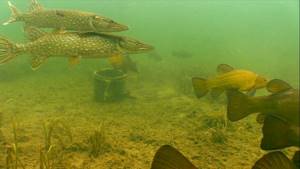
One female pike lays from 17.5 to 215 thousand eggs, the number of eggs in a female depends on her age and size. For example, a pike weighing 2.5 kg is capable of producing 136 thousand eggs. The pike egg has a diameter of about 3 mm. The eggs are sticky, due to which they attach to grass, algae and other underwater vegetation.
If after the spawning of pike there is a rapid decline in water, then most of the eggs dry out and die.
After 2-3 days, the stickiness of the eggs disappears and they fall to the bottom, where a larva, 6.7-7.6 mm long, develops from it within 8-14 days. The rate of development of the larvae from the eggs depends on the temperature of the water in the reservoir.
As the bubble dissolves, pike larvae begin to feed on zooplankton, small crustaceans and begin to grow rapidly. The pike larva, with a length of only 12-15 mm, is already beginning to prey on the larvae of carp fish. Spawning of carp fish occurs much later than the spawning of pike; cyprinid larvae become food for young pike.
Pike fry begin to eat insects, worms, eggs and fish larvae, and having reached a length of 5 cm, they begin to hunt and completely switch to feeding on small fish.
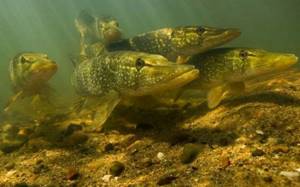
Pike fry often become prey for other predatory fish, birds and animals. Adult pike and pike perch happily eat small pike perch. Among the birds there are ducks and seagulls, and among the animals the muskrat is also not averse to feasting on small bee-eaters.
Pike fry grow quite quickly, being born in April-May, by autumn they grow up to 15 cm and weigh about 100 grams. The growth of pike fry depends on the availability of food supply. In reservoirs with a rich food supply, pike at the age of 1 year reaches a length of 30 cm, and a pike at the age of 2 years reaches a length of 40 cm and weighs about 1 kg. The older the pike gets, the slower it grows in length, but the faster it gains weight. Pike at the age of 5 years gains only 2 cm in length per year.
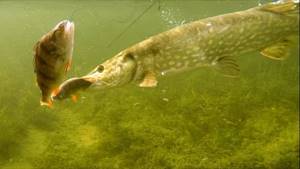
It happens that pikes enter flood lakes in the spring, after a while the water subsides, the connection between the lake and large water is interrupted and the pikes find themselves locked in such a reservoir. In such a locked reservoir, pike experience a lack of food resources, the growth of pike here is very uneven, pike of the same age differ in length by 2 - 2.5 times.
In such a reservoir, pike fry feed on zooplankton, larger pikes feed on pike fry, and the largest pikes feed on medium-sized pikes. Reservoirs of this type are often found in Yakutia and Canada.
"The Jagged-Toothed Robber." The pike doesn’t bite these days: it’s changing its teeth.
Just the other day, while flipping through various fishing forums to find out what was being caught and where, I came across an interesting correspondence. Fishermen in the Astrakhan region say that the toothy bite has sharply declined. And there is a reason for this!
Rare caught specimens, almost all toothless, like ancient old women! What a misfortune, what happened to this toothy killer machine?! Did the ever-present caries really not spare the fish tribe?! Or does pike have a seasonal “teeth molt” and is capable, in preparation for the new hunting season, of completely renewing its hunting arsenal?! The question is, of course, interesting and, I think, will interest not only beginners, but also respected EXPERTS in their field! I personally, in all the time that I have been fishing, have never met a toothless “toothy”.
Well, let's turn to the respected founding fathers of fishing science for an answer!
In his book “Fishes of Russia” L.P. Sabaneev
writes:
".
Probably everyone had to catch fish with wide wounds on the sides and at the tail - these are marks of pike teeth. large prey manages to escape from the predator’s mouth when its teeth change : the old ones fall off and are replaced by new, still soft ones. This curious phenomenon usually occurs in May; . “ He writes further .”
pike replaces teeth more than once a year. and monthly at the new moon: at this time her teeth begin to loosen, often become stained and deprive her of the ability to attack. "
Well, the answer to the question seems to have been given, because if you don’t trust Sabaneev, you’ll be beaten with the clubs of the entire fishing lads! But what about your own experience?! Well, I haven’t seen a toothless pike, even if you crack it!
After digging through a bunch more material about this interesting predator, I came across an excerpt from the works of Dmitry Illarionovich Kolganov. ("Fish farming and fishing" 1968)
This is very interesting material. The author meticulously, from 1937 to 1967, studied the structure of the jaws of pikes at different periods of their life. The article is voluminous and, I think, cannot be recounted in detail. The essence of the study comes down to the fact that the pike never completely sheds its teeth, but replaces them in parts, constantly, as the old ones chip and wear out, year-round, throughout its life.
Indeed, often looking at the mouths of caught pikes, I had to observe both broken fangs and, at the same time, the presence of soft, fragile teeth. I think that, nevertheless, the pike never sheds its teeth completely. Otherwise, she would simply die of hunger, because new ones won’t grow in a few days!
That’s why the pike is called “toothy” and not “temporarily toothless” or “chapped”!
Pike fishing
Pike is a popular object of recreational fishing. Pike is caught in a variety of ways: spinning, fly fishing, float and bottom fishing rods, girders, circles.
Pike is the most popular prey when fishing with a spinning rod. Pike are caught using rotating and oscillating spoons.
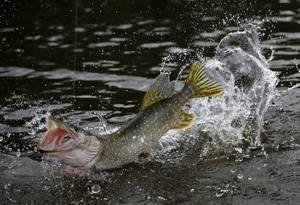
In many fishing areas, when fishing with a spinning rod, wobblers for pike give good results. Where it is difficult to place a lure, you can fish with surface wobblers: poppers, walkers, gliders, crawlers. The fisherman throws a wobbler into windows clear of underwater vegetation. Wobblers, along with silicone baits, show good results when catching pike at depth.
During periods when the pike is in a passive state and does not want to react to other baits, the use of lead rigs can give a good result: drop-shot, Carolina, Texas rig or retractable leash.
Pike can be caught by fly fishing; for this purpose, fairly powerful rods, lines of the appropriate class and special pike streamers are used.
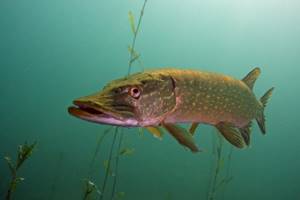
When fishing with a float and bottom fishing rod, tackle using live bait is especially effective. This kind of gear can be cast further from the shore; a live fish does not arouse suspicion among the pike and is a very tempting prey. Pike do not swallow live bait right away, so there is no need to rush into hooking. The best time for pike fishing in summer is morning and evening hours, when pike are most active. In autumn, the best time for fishing is the middle of the day, when the water is warm enough.
In the winter season, pike are caught using jigs, spoons and balancers. The best time to catch pike is in winter on the first and last ice. In the middle of winter, during the so-called wilderness, pike is inactive, it is in the lower layers of the reservoir, feeds little, and reacts poorly to bait floating even nearby. In winter, pike moves little around the reservoir, and when absolutely necessary, it does so very slowly.
What you need to know about lake pike?
- It leaves wintering much later than the river one, and retires even earlier.
- Its spring feeding begins even when the reservoir is covered with ice, so it is almost impossible for a spinner to approach it.
- The absence of bites in a lake can last for almost two months, since the water warms up greatly during this time, especially if it is small and not very deep.
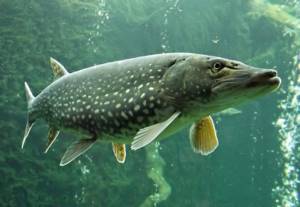
Pike is the dream of every fisherman; everyone dreams of catching a large beauty on their hook. Catching small pike (less than 1 kg) is prohibited and is considered poaching. Also, when fishing with a hook, be careful and do not grab the prey with your bare hands, it can easily bite.
Pike in cooking
Pike is sold in fish stores in live, chilled, frozen and canned form. Pike sold live has the best taste.
Pike meat is considered a valuable dietary product; it contains 18% protein and 1-3% fat, therefore it is recommended for overweight people.
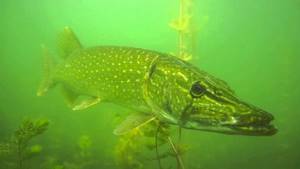
Pike meat has a pleasant taste, it is white, flaky, but its culinary qualities are not very highly valued due to its bonyness and the smell of mud.
In the past, in England, pike was considered one of the most delicious and expensive fish; in many countries, and in our time, pike dishes are considered delicacies.
There are a large number of recipes for cooking pike. It is best to fry small pike or make fish soup from it.
Large and medium pike are good for making fish cutlets and meatballs.
